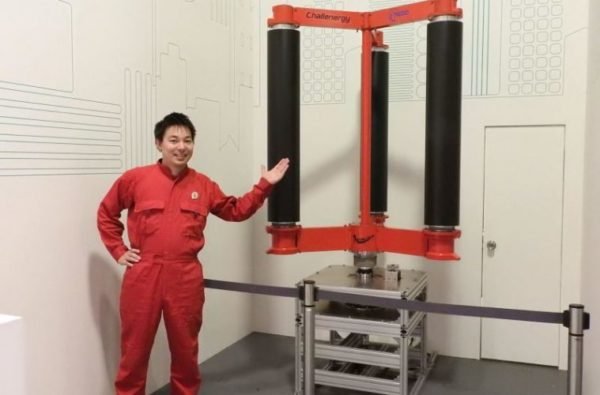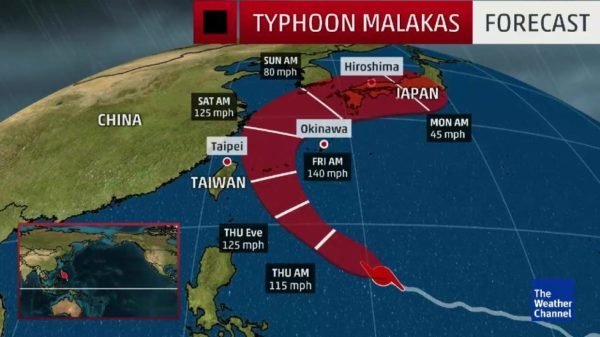
The typhoon is an extremely large, powerful, and destructive storm that is very common in the Far East, especially in the Philippines, the China Sea and north of the Pacific Ocean, towards Japan.
Of course, it is associated with destruction. Whenever a typhoon occurs, it comes with a huge cost. Both properties and human lives are lost.
On the island nation of Japan in the Pacific Ocean, typhoons are very common. The country has become used to the situation, as there is no way to stop Mother Nature. In fact, the country has already seen six typhoons in 2016 alone. The destruction these typhoons have cost the country cannot be estimated. Many lives and properties have been lost throughout these monster storms.
However, an enterprising engineer in the country has invented something that is just about to turn typhoons in the country from sad sorrows to joyful and useful.
According to Collective Evolution, engineer Atsushi Shimizu has constructed a new wind turbine capable of harnessing the immense power of these storms produced by typhoons, in order to turn it into useful energy. It is said if his project is successful, a single typhoon would have the ability to power the entire Japanese nation for 50 years. This good news has given Japan a new hope, regarding its energy demand. Energy produced by the wind turbine is clean and renewable. It does not pollute the environment or the atmosphere. It is not a threat to human lives as compared to the more traditional sources of energy.

Before the Fukushima disaster, it was expected that nuclear power would account for 60% of Japan’s primary energy by 2100. However, the earthquake and tsunami that killed 19,000 people also resulted in three nuclear breakdowns, putting that plan entirely off track. Currently, many of Japan’s nuclear reactors are inactive. Japan imports roughly 84% of its energy requirements, which is obviously not good news for the country.
Although Japan was relying heavily on nuclear energy before the disaster, the country was still eying renewable sources. The country was building wind turbines before the Fukushima disaster but the turbines were not designed to withstand the extreme storms in the country. In 2013, during Typhoon Usagi, eight turbines reportedly collapsed at China’s Honghaiwan wind farm, in eastern Guangdong. An additional eight were further damaged. Such unsuccessful efforts have led the Japanese government to focus on solar power, with many urban homes now incorporating solar panels.
Shimizu believes in the potential of Japan’s untapped wind power. At the launch of his invention, Shimizu said: “Japan actually has a lot more wind power than it does solar power, it’s just not utilized. For decades, Japan has brought in European-style wind turbines, not designed for typhoon zones, and installed them with no careful consideration, they’ve broken almost entirely.”
It is said Shimizu’s typhoon turbine is unlike conventional turbines. It works on an omnidirectional axis to allow for the machine to withstand unpredictable wind patterns. The speed of the blades can be adjusted to prevent them from spinning out of control when a storm hits.
Called the Magnus effect, the sideways force that makes a spinning object stray from a straight path offers an astonishing amount of control over the turbine’s blades. Engineers can adjust the speed of the blades by simply tightening the centre rod.
The first prototype of the turbine has been tested. It showed 30% efficiency, 10% lower than propeller-based turbines. However, the big difference to take note here is that Shimizu’s turbines are capable of surviving an actual storm.
According to how Shimizu started his invention, in 2013, he quit his job and founded Challenergy. Thereafter, he won funding to invent his ambitious wind turbine. So far, the functional prototype has been installed near Okinawa. Shimizu is now waiting for the turbine to be tested under high-wind conditions to see if it holds up to his expectations. If it is successful, Japan will benefit immensely from his invention.
The huge energy produced will go directly to the national grid, while the extra will be stored in larger batteries. The country will also export some, turning the table around in its favor.
hello @anonnews
wow, thanks for sharing this post.
good content brother!
it's awesome!
Downvoting a post can decrease pending rewards and make it less visible. Common reasons:
Submit
Coool ! Thank you so much for sharing! 😗😙😚🤗🤗🤗
Downvoting a post can decrease pending rewards and make it less visible. Common reasons:
Submit
Resteemed, interesting topic.
Downvoting a post can decrease pending rewards and make it less visible. Common reasons:
Submit
Nice to see high quality posts out there!
Downvoting a post can decrease pending rewards and make it less visible. Common reasons:
Submit